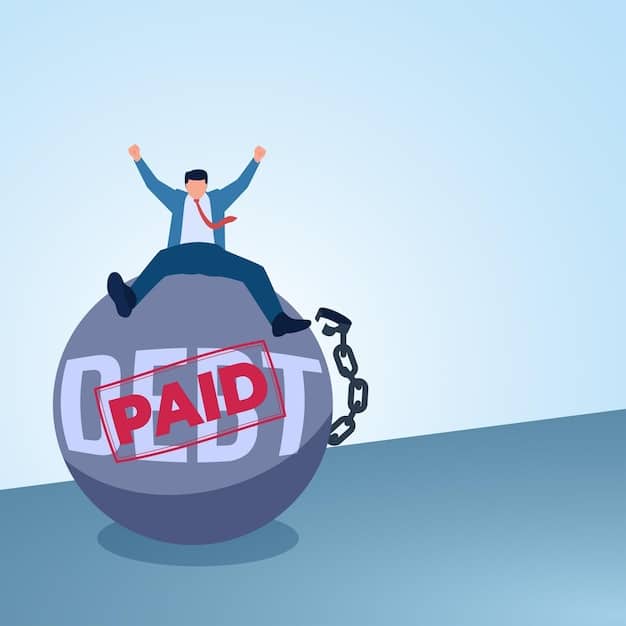Debt Snowball vs. Debt Avalanche: Which Saves More in 2025?

Debt Snowball and Debt Avalanche are two popular debt repayment strategies; while the Debt Snowball focuses on psychological wins by paying off smaller debts first, the Debt Avalanche targets high-interest debts to minimize overall interest paid, making it potentially more cost-effective in 2025.
Are you looking to tackle your debt in 2025 but unsure where to start? The Debt Snowball vs. Debt Avalanche: Which Money Management Strategy Saves You More in 2025? debate is a common one, and understanding the nuances of each can help you choose the best path for your financial situation.
Understanding the Debt Snowball Method
The Debt Snowball method is a debt reduction strategy where you pay off your debts in order from smallest to largest, regardless of the interest rate. This method focuses on providing quick wins to keep you motivated.
Here’s a closer look at the core principles:
How the Debt Snowball Works
The Debt Snowball method involves listing all your debts from the smallest balance to the largest. You make minimum payments on all debts except for the smallest one. Put every extra dollar you can find toward paying off that smallest debt. Once it’s paid off, you take the money you were paying on it and “snowball” that payment into the next smallest debt. The idea is that as you pay off each debt, you have more money to put toward the next one.
Psychological Benefits
One of the biggest advantages of the Debt Snowball method is the psychological boost it provides. Seeing debts disappear quickly can be incredibly motivating, helping you stick to your repayment plan. This can be particularly useful if you struggle with staying focused on long-term goals.
However, it’s essential to be aware that this method may not always be the most financially efficient.

- Boosts Motivation: Quick wins keep you engaged.
- Simple to Understand: Easy to implement and track progress.
- Reduces Stress: Seeing debts disappear can lower financial anxiety.
The Debt Snowball method is best suited for individuals who need a motivational boost to stay on track with their debt repayment goals. It’s a great way to build momentum and develop good financial habits.
Exploring the Debt Avalanche Method
The Debt Avalanche method, on the other hand, is a debt reduction strategy where you prioritize paying off debts with the highest interest rates first. This aims to save you the most money over time.
Let’s delve into its mechanics:
How the Debt Avalanche Works
With the Debt Avalanche method, you prioritize your debts based on their interest rates, from highest to lowest. You make minimum payments on all debts except for the one with the highest interest rate. Put every extra dollar you can find toward paying off that high-interest debt. Once it’s paid off, you move on to the debt with the next highest interest rate, and so on. This strategy aims to minimize the total interest paid over the life of your debt.
Financial Efficiency
The primary advantage of the Debt Avalanche method is its potential to save you more money in interest payments. By targeting high-interest debts first, you can reduce the overall cost of your debt repayment. This makes it a more efficient strategy from a purely financial perspective.
- Saves Money: Reduces overall interest paid.
- Financially Efficient: Targets high-interest debts first.
- Strategic Approach: Focuses on long-term financial benefits.
The Debt Avalanche method is ideal for those who are disciplined and motivated by long-term financial savings. If you can stay focused on the ultimate goal of reducing your debt burden, this method can be very effective.

Comparing the Savings in 2025
When comparing the Debt Snowball and Debt Avalanche methods, it’s essential to consider the potential savings each offers. The Debt Avalanche often leads to lower overall interest payments, but the Debt Snowball provides quicker psychological wins.
Here’s a breakdown of what to consider:
Interest Rate Impact
The Debt Avalanche method directly targets high-interest debts. For example, if you have a credit card with a 20% interest rate and a student loan with a 6% interest rate, the Debt Avalanche method would prioritize paying off the credit card first. This can save you a significant amount of money over time, especially if the high-interest debt has a large balance.
Time to Completion
The Debt Snowball method might take longer to complete overall, as it doesn’t focus on interest rates. However, the motivation from seeing debts disappear quickly can help you stay on track. Depending on the interest rates and balances of your debts, the Debt Avalanche usually results in paying less interest and becoming debt-free sooner.
Real-World Examples
Consider two individuals with the same debts:
- Person A: Uses the Debt Snowball method and pays off several small debts quickly, gaining momentum and staying motivated.
- Person B: Uses the Debt Avalanche method and focuses on the highest interest debt. Although it may take longer to see initial results, they save a substantial amount on interest payments.
In many cases, Person B ends up paying less in the long run, but Person A might be more likely to stick with the plan due to the quick wins.
The Role of 2025 Economic Factors
Economic conditions in 2025 can further influence which debt repayment strategy is more beneficial. Factors such as interest rate fluctuations and inflation can impact the overall cost of your debt.
Here’s how economic factors can play a role:
Interest Rate Fluctuations
If interest rates are expected to rise in 2025, paying off high-interest debts sooner rather than later becomes even more critical. The Debt Avalanche method can help you lock in savings before rates increase further.
Inflation Impact
Inflation can erode the real value of your debt over time. However, it also means that the interest you’re paying becomes more expensive in real terms. Both the Debt Snowball and Debt Avalanche methods can help you combat the effects of inflation by reducing your overall debt burden more quickly.
Job Market Stability
A stable job market can make it easier to commit extra funds to debt repayment. If the job market is uncertain, having a debt repayment plan like the Debt Snowball can provide psychological comfort, while the Debt Avalanche can minimize long-term costs if you maintain consistent payments.
Making the Right Choice for You
Selecting the right debt repayment strategy depends on your financial situation, psychological preferences, and external economic conditions. There’s no one-size-fits-all answer; it requires careful consideration of the pros and cons of each method.
Consider these factors:
Assess Your Financial Situation
Start by listing all your debts, including balances, interest rates, and minimum payments. Next, realistically assess your budget to determine how much extra you can allocate towards debt repayment each month. This will inform your decision between the Debt Snowball and Debt Avalanche methods.
Consider Your Personality
Are you more motivated by quick wins, or are you able to delay gratification for long-term financial gains? If you need to see immediate progress to stay motivated, the Debt Snowball might be a better fit. If you’re disciplined and focused on saving money, the Debt Avalanche could be more effective.
Consult a Financial Advisor
If you’re still unsure which strategy is right for you, consider consulting a financial advisor. They can provide personalized advice based on your specific circumstances and help you create a comprehensive debt repayment plan.
| Key Aspect | Brief Description |
|---|---|
| 🎯 Debt Snowball | Prioritizes paying off smallest debts first for motivation. |
| 💰 Debt Avalanche | Focuses on highest interest debts to save money. |
| 📈 Interest Rates | Avalanche saves more if high-interest debts are significant. |
| ⚖️ Economic Factors | Economic conditions can influence strategy benefits. |
Frequently Asked Questions
▼
The Debt Snowball focuses on paying off the smallest debts first for psychological wins, while the Debt Avalanche focuses on paying off the debts with the highest interest rates first to save money.
▼
The Debt Avalanche method typically saves more money in the long run because it prioritizes paying off high-interest debts first, reducing the overall interest paid over time.
▼
Many people find the Debt Snowball method easier to stick with because the quick wins from paying off small debts provide motivation to continue with the repayment plan.
▼
Economic factors like rising interest rates and inflation can make the Debt Avalanche method more appealing, as it addresses high-interest debts quickly, minimizing the impact of rising rates.
▼
Yes, consulting a financial advisor is always a good idea. They can assess your specific financial situation and provide personalized guidance to help you choose the most effective debt repayment strategy.
Conclusion
In the **Debt Snowball vs. Debt Avalanche: Which Money Management Strategy Saves You More in 2025?** debate, the best approach depends on individual circumstances. If you need quick motivation, the Debt Snowball can be effective. However, if you are disciplined and focused on long-term savings, the Debt Avalanche may be the better choice.





